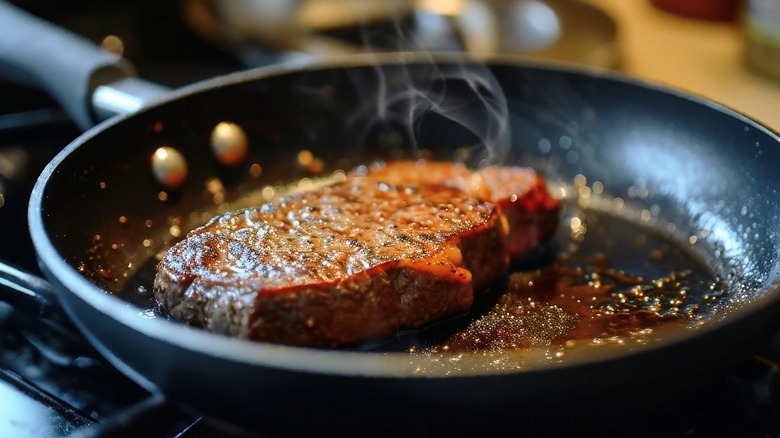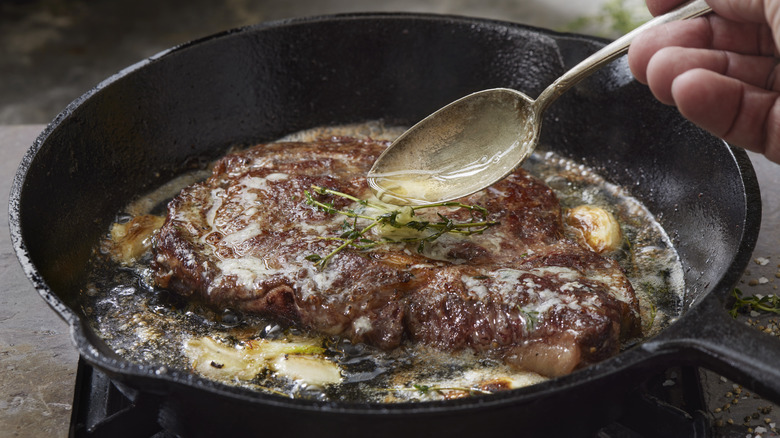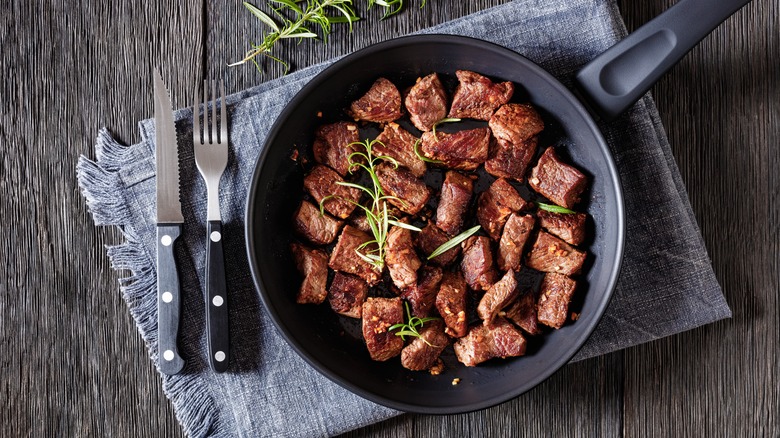Is It Better To Sear Foods In A Cast Iron Or Non-Stick Skillet?
We may receive a commission on purchases made from links.
When you've invested in the perfect steak, you want it cooked to absolute perfection. The key to nailing that restaurant-quality crust? Searing. And if you're doing it on the stovetop, the pan you choose can make or break the result. If you need to decide between non-stick and cast iron, cast iron wins hands down. Its ability to reach and maintain high heat makes it the ultimate tool for achieving a flawless sear, whether you're working with steak, scallops, chicken, fish, a roast, or even vegetables.
Non-stick pans have their perks — like being easy to clean and not needing to be seasoned like cast iron — but they fall short when it comes to high-heat searing. You can technically sear foods in a non-stick skillet, but you'll need to be careful. High heat can damage the coating, lead to potential health risks, and shorten the life of your cookware. Plus, if you're hoping to create a rich, flavorful pan sauce afterward, non-stick won't give you those essential savory browned bits, commonly referred to as fond, to deglaze.
On the other hand, a cast iron skillet, like Lodge's trusty pre-seasoned pan, excels at withstanding high heat to form the perfect crust and gives you those flavorful bits for a killer sauce. Other solid options for searing include stainless steel or carbon steel pans, which also handle heat well and offer similar benefits to cast iron.
Pan searing with cast iron
Searing is key to a delicious cut of meat, but not for the reason you might think. Searing a steak doesn't lock in its juices, as many believe, but instead is used to develop the complex flavor that comes from caramelization and browning. To achieve this, start by heating your cast iron skillet until it's smoking hot — literally. You want the pan to be scorching before adding the meat, as this high heat is what triggers the Maillard reaction that changes the color of meat as it cooks. Once the meat hits the pan, resist the urge to move it. It'll stick at first, but that's a good thing — as the crust forms, the meat will naturally release when it's ready to be flipped.
For best results, remember not to overlook the prep work. Let your meat rest at room temperature for about 30 minutes before cooking and be sure to pat it completely dry. Any excess moisture will interfere with getting that optimal sear you're after. And, once your food is cooked to perfection, be sure to make a pan sauce with the tasty fond that's left behind.
Pan searing with non-stick
While non-stick might not be as foolproof as cast iron, it can still work for searing. A good-quality non-stick skillet, like All-Clad's hard anodized frying pan, can withstand occasional high temperatures when used right. The key is to avoid heating it for too long or too often, and being able to recognize the differences in how it functions. You'll still want to avoid common mistakes that ruin pan-seared meat. Plus, the prep work is the same: Remove the meat from the fridge 30 minutes before cooking and pat it dry before adding it to the pan.
To sear in a non-stick skillet, start with a cold pan with your preferred cooking fat. (Some cooks suggest skipping the fat altogether, so you may want to test both methods.) Place your food in the pan, then turn the heat up to high. Flip it frequently to ensure even browning on both sides. Once you've achieved a nice sear, lower the heat to finish cooking. Just keep in mind that non-stick won't produce the fond that you'd get with cast iron, meaning you'll miss out on making a pan sauce with the same flavor depth.


